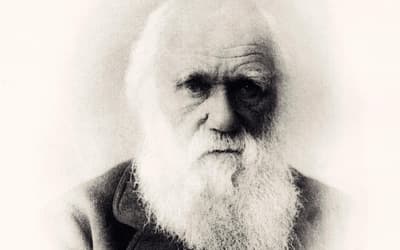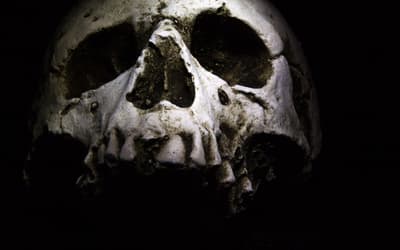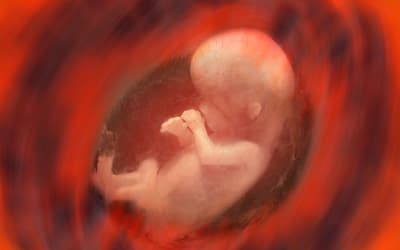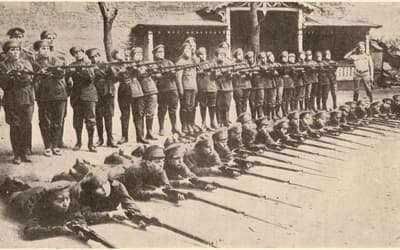The views expressed in this paper are those of the writer(s) and are not necessarily those of the ARJ Editor or Answers in Genesis.
Abstract
This is a review of the history of an attempt to prove Jewish racial inferiority by selecting Jews who fit the racial stereotype, then murdering them, and processing the bodies for display in a German university museum. In the end, the researchers were unable to find any evidence of Jewish racial inferiority as predicted by the anthropology and medical academic community of the time. The cost in terms of lives and suffering included over 100 innocent people who were murdered to prove a theory that turned out to be not only wrong but based on an erroneous secular philosophy, namely Darwinism. This display was one result of the rejection of the Genesis account that teaches all men are descendants of our first parents, Adam and Eve; thus all humans are of one race (the human race) and one kind (mankind).
Keywords: Introduction to the Jewish Skeleton Collection History, Holocaust, Racism, Nazism, Darwin-based racism, Auschwitz, Social Darwinism, Ernst Haeckel, de Gobineau
Introduction
A claim by some historians is that the Jewish Holocaust was caused purely by anti-Semitism. In fact, as has been well-documented, Darwinian-based racism was a central factor in causing the Holocaust (Bergman 2010, 2012; Müller-Hill 1998; Weikart 1998, 2004, 2009). One of many examples of evidence for this fact is the extensive, detailed study of Jewish skeletons undertaken by Nazi collaborators in an attempt to scientifically prove the racial inferiority of the bodies of Jews. Exactly what the scientists were looking for is unknown, but it is clear that the skeleton collection was driven by the belief that Jews were biologically inferior humans. Some common characteristics listed supporting this ill-founded notion included especially facial traits of the nose, mouth, chin, forehead, and eye and hair color, as well as body-build. This belief in Jewish inferiority led to the proposal that a careful study of Jewish skeletons and body organs would provide scientific support for this view. This goal led to selecting appropriate examples of Jews that fit the racist stereotype as outlined by various anthropology references. After the subjects were identified, they were murdered, their bodies were studied, some organ(s) removed for further study, and then all of the flesh was removed with the goal of placing their skeletons in German museums to document German racial theories.
Motivations for the Skeleton Collection
One of the most important works motivating the Jewish-body inferiority belief was French writer Arthur de Gobineau, who argued that there are major differences between human races and the Aryan race was superior (Gobineau 1966). Furthermore, as taught by eugenicists, civilizations decline and fall when the superior race is generically mixed with inferior races, such as the Jews. Another professor who was very influential in the Nazi racial belief was
the greatest avowed follower of Darwin in the world of German science, Ernst Haeckel, . . . clearly saw humanity in terms of a hierarchy of superior and inferior races, and the white Aryan race, particularly the Germans, was at the top, the ‘Semitic’ Jews inferior. (Beller 2015, 60)
In the Germanic countries at this time, “Darwinian rhetoric was widely accepted within medical circles and a discussion about race also ensued among eugenically inclined members of the . . . medical community.” Social Darwinism “had become ‘the way to translate political discourse into biological language’” (Uzarczyk 2007, 287). Also, at this time, “Jewish racial status became a matter of heated discussion among anthropologists” (Uzarczyk 2007, 287). One of the leading works supporting the belief that the Aryan race was superior included the German translation of Gobineau’s work noted above. The 1897 German translation Versuch über die Ungleichheit der Menschenrassen was by Ludwig Schemann “one of the most important racial theorists of imperial and Weimar Germany” (Levy 2005, 640). Gobineau had a close relationship with Richard Wagner, a man Hitler admired greatly and whose ideas he emulated (Mosse 1978, 56).
Support by the Professoriate
The Nazi race professors were so confident of their Darwinian view of race that they planned to set up a public display of Jewish skeletons to help convince the public at large of their claims about Jewish biological inferiority. Another pressing reason for the collection was the belief that since Jews were “a race on the brink of total extermination,” the Nazis felt Jewish skeletons and organs needed to be preserved for future scientific research on inferior races (Weindling 2015, 154).
The plethora of skeletons of Jews murdered to obtain the collection was only one of many attempts by the Nazis to prove Jews were Üntermenschen (sub-humans/inferior people), in contrast to the Aryan Germans, which the Nazis considered Übermenschen (super-humans/superior people). The race scientists also collected anatomical samples for study in their attempts to document Jewish inferiority (Toledano 2016, 128). The program was sponsored by the German “think tank” called the Ahnenerbe office to carry out various scientific studies on race, especially members of what the leading scientists then determined were inferior races, including Jews, Slavs, Negroes, and Gypsies (Lifton 1986, 286).
The Professor August Hirt and the Anthropological Skeleton Display
The Nazi’s anthropological skeleton display was also created and designed to help justify Nazi programs against Jews. Involved in this project were the nation’s leading anthropologists, scientists and medical professionals, all of whom supported the belief in the “innate superiority of the ‘Aryan’ folk” (Messing 1976, 326). The leader of the project, Professor August Hirt (1898–1945), held professorships at several major German Universities. Dr. Hirt and his mentor, Professor Phillip Ellinger, published eight articles in peer-reviewed scientific journals (Toledano 2017). This pair of scientists also invented one of the most important microscopic developments of the last century, the fluorescent microscope system (Toledano 2016, 131). Since Professor Ellinger was Jewish, he was forced to resign from the University when the Nazis came to power.
Professor Toledano writes about one tragic fallout of the termination of Ellinger was that Hirt “did not support the man [Ellinger] who had been his mentor . . . between 1925 and 1931” (Toledano 2016, 131). Hirt even claimed “to be the sole inventor of the microscope . . . and claimed sole authorship” of their work (Toledano 2016, 131). Hirt was a fervent nationalist and both a member of the Nazi Party and the SS—the “Schutzstaffel,” German for “Protective Echelon”—the Nazi’s major paramilitary organization.
Ellinger was only one of many Jewish professors who achieved eminence in Germany, a fact that illustrates that belief often trumps fact. Many Nazi racists harmonized their belief by claiming that Jews were not intellectually inferior but rather morally and physically inferior as argued by Nott and others even before Darwin published his Origins book (Nott 1856). As Herf writes,
Culminating in the caricatures that filled the pages of Julius Streicher’s Der Stürmer, they depicted a stereotyped Jewish body held to be physically inferior in every way to an idealized vision of the beautiful Aryan body. They viewed Jews’ alleged physical ugliness as innate evidence of moral inferiority. (Herf 2018)
The collection was originally to be housed where the initial preparation of the corpses was completed, namely, at the Anatomy Institute of the University of Strasbourg. The collection, sanctioned by the SS Reichsführer, Heinrich Himmler himself, was under the direction of Professor Hirt and Dr. Rudolf Brandt. Dr. Wolfram Sievers was responsible for procuring and preparing the corpses to be used in the inferior-human skeleton display. The collection was part of the racial work of several eminent German anthropologists at the Kaiser Wilhelm Institute. The Kaiser Wilhelm Society was supported by many eminent German scientists, including
Otto Hahn, Albert Einstein, Max Planck, and Werner Heisenberg, scientific giants active at a time when Germany was a scientifically dominant nation. That era came to an abrupt end when Hitler rose to power and the Nazis ousted many of the best scientists because they were Jewish. (Pääbo 2014, 80)
This scientific institute soon became a central part of the Nazi war machine and its racist pursuits. Furthermore, “through its Institute for Anthropology, Human Heredity, and Eugenics,”
the Kaiser Wilhelm Society was actively involved in racial science and the crimes that grew out of that. In that institute, based in Berlin, people like Josef Mengele were scientific assistants while performing experiments on inmates at Auschwitz death camp, many of them children. Whereas Mengele was sentenced for his crimes after the war (although he had escaped to South America), his superiors at the Institute for Anthropology were never charged. On the contrary, some of them became professors at universities (Pääbo 2014, 80–81).
The original plan was to obtain “specimens” for the collection from the bodies of Jews originally captured by the Wehrmacht on the Eastern Front. The individuals ultimately chosen for the anthropological research were obtained from a pool of 115 Jewish inmates at the Auschwitz concentration camp in occupied Poland. They were not intended to be a representative sample of Jews but were chosen specifically because their appearance conformed to the stereotypical, inferior-Jewish racial characteristics. Nonetheless, it soon became clear to the researchers that “the Jewish race was racially complex” and manifested a wide range of external physical traits (Weindling 2015, 155).
The initial selections and preparations were carried out by doctors Bruno Beger and Hans Fleischhacker. These scientists arrived in Auschwitz in the first half of 1943 and completed their preliminary work on their Jewish victims by June 15, 1943. Due to a typhus epidemic in the camp, the candidates chosen for the skeleton display were quarantined to prevent them from becoming ill and ruining their evolutionary anatomical value. Sievers reported on the preparation status, writing in June of 1943 that of 115 persons selected at that point: “79 were Jews, 30 were Jewesses, 2 were Poles, and 4 were Asiatics. At the present time these prisoners are segregated by sex and are under quarantine in the two hospital buildings.” (Spitz 2005, 231)
The victims selected were then sent to the Natzweiler camp near Strasbourg and were part of the thousands of men and women murdered at this concentration camp site. The camp complex was
surrounded by electrified barbed wire, its barracks overrun with lice and typhus, the chimney above its crematorium constantly belching acrid smoke into the mountain air . . . Between 1941 and 1945, disease, hunger, routine barbarity, and the gas chamber claimed nearly twenty-two thousand lives. It was at Natzweiler that eighty-six Jewish men and women were gassed to provide anatomical specimens for the Jewish skeleton collection, an exhibit the Nazis hoped to display at the planned Reich University of Strasbourg to highlight the physical inferiority of the Jewish race. (Read 2012, 132)
The delegate in charge of securing the victims was instructed to take a series of photographs, anthropological measurements, and, in addition, to determine as far as possible the background, date of birth, and other relevant information required for their racist research (Spitz 2005, 232). To properly complete their “anthropological research” on race, measurements “of all the parts of the body” were taken (Lifton 2001, 284). One focus was the heads and brains in order “to capture the Jewish distinctiveness” (Weindling 2015, 156).
Ultimately, a total of 86 persons, 57 men and 29 women, were sent to Natzweiler-Struthof. Of the specimens, 46 were originally from Thessaloniki, Greece. The deaths of these inmates were “induced” in an improvised gassing facility. The last commandant of Bergen Belsen personally carried out the gassing of 80 of the 86 victims. The researchers had installed a one-way mirror in the gas chamber to allow the scientists to observe the deaths of the subjects, “as part of the necessary research,” to determine if inferior races die differently than superior races. One male victim fought so vociferously to keep from being gassed that he was ultimately shot (Weindling 2015, 156). Lastly, the corpses were sent to Strasbourg for preparation for research.
The first step of the process of preparing the bodies for the display was to make anatomical casts of them prior to reducing the bodies to skeletons. Then, following the murder, the doctors were careful not to damage the specimens’ heads. They were separated from the body and forwarded to the proper “destination in a hermetically sealed tin can, especially produced for this purpose and filled with a conserving fluid” to preserve them for future racial research (Spitz 2005, 232).
The plan was to complete various comparison tests and detailed anatomical research on the skulls in an attempt to document the form and size of the brain to prove their racial inferiority and to record other pathological racial features. The photos, measurements, and other data on the head and skull were to be used to help document the evolutionary anthropological belief in the inferiority of the Jewish “race.”
As the allies approached in 1944, concern existed over the possibility that the corpses, which had not yet been de-fleshed, could be discovered. As a solution, in September of 1944 Professor Sievers telegrammed Brandt informing him that the collection must immediately be de-fleshed to be rendered unrecognizable. This order would result in this collection being “lost to science, since it would now be impossible to make plaster casts” (Spitz 2005, 233).
Failure to Prove Jewish Inferiority
The following extract from a report that Sievers submitted to SS head officer Heinrich Himmler and was read at the Nuremberg Doctors’ Trial by General Telford Taylor, Chief Counsel for the prosecution at Nuremberg. This report explains that, in spite of using a biased sample, the scientists realized that their research failed to prove that Jews were Üntermenschen: “We have a nearly complete collection of skulls of all races and peoples at our disposal. Only very few specimens of skulls of the Jewish race, however, are available with the result that it is impossible to arrive at precise conclusions from examining them” (Spitz 2005, 231–232). The solution to this problem was the war in the East that presented the scientists
with the opportunity to overcome this deficiency. By procuring the skulls of the Jewish-Bolshevik Commissars, who represent the prototype of the repulsive, but characteristically subhuman, we have the chance now to obtain a palpable, scientific document. (Spitz 2005, 231–232; italics in original).
In other words, their sample failed to prove their theory, so they planned to obtain another sample that they felt would better help them document their Darwinian racist goal. The report further added the best “method for obtaining and collecting this skull material could be handled by directing the Wehrmacht to turn over all captured Jewish-Bolshevik Commissars alive to the Field Police” (Spitz 2005, 232).
The End of the Jewish Skeleton Researchers
Drs. Brandt and Sievers were both indicted, tried, and convicted in the Doctors’ Trial in Nuremberg for murdering 112 Jews for the skeleton collection which was to be displayed at Reich University (Spitz 2005, 231). Both Brandt and Sievers were hanged in Landsberg Prison on June 2, 1948 (McDonald 2000). Josef Kramer, Commandant of Natzweiler-Struthof concentration camp, was also convicted of war crimes and hanged by the British on December 13, 1945. Other scientists involved in the Jewish skeleton fiasco, including Dr. Otto Bickenbach, Dr. Friedrich Bickenbach, and Dr. Helmut Ruehl, were accused of committing war crimes. Rather than face the hangman, August Hirt, chairman of Reich University in Strasbourg, committed suicide by a gunshot to the head in Schönenbach, Austria, on June 2, 1945 (Toledano 2016, 131).
No Remorse for Their Crimes
In 1974, Bruno Beger was convicted by a West German court as an accessory to 86 murders for his role in procuring the victims for the Jewish skeleton collection. Although sentenced to the minimum term of three years imprisonment, he did not serve any prison time. He died in Königstein in Taunus on October 12, 2009. Ironically, during the trial, “none of the defendants evinced any remorse . . . and many defended their work as ‘good science’” (Clarfield 2006, 2668).
One example of the victims of the Jewish skeleton collection project was the successful Berlin dairy merchant named Menachem Taffel, a Polish-born Jew who, along with his wife and child, was deported to Auschwitz in March of 1943. His wife and child were murdered by gassing on arrival, and Menachem was chosen to be an anatomical specimen. He was then shipped to Natzweiler-Struthof concentration camp and murdered in the gas chamber there in August of 1943.
Taffel was positively identified through the efforts of Serge and Beate Klarsfeld. In 2003, University of Tübingen professor Dr. Hans-Joachim Lang succeeded in identifying the rest of the victims by comparing a list of inmate numbers of the 86 corpses at Strasbourg, that were surreptitiously recorded by Hirts’ French assistant, Henri Henrypierre, with a list of inmate numbers vaccinated at Auschwitz. The names, various background data, and other biographical information of the murdered victims were published in the book Die Namen der Nummern (that is, The Names of the Numbers) (Lang 2004).
The Attempt to Memorialize Those Who Were Murdered
In 1951, the remains of all 86 victims were reinterred in the Cronenbourg-Strasbourg Jewish Cemetery. On December 11, 2005, memorial stones engraved with the names of the 86 victims were placed in this cemetery. A plaque honoring the victims was also placed outside the Anatomy Institute at Strasbourg’s University Hospital. Thus ended the attempt to use Darwinian-inspired racism to prove the inferiority of the Jewish race (Clarfield 2006; Mellanby 1947). The attempt to document the inferiority of Jews would have never commenced if the professors and doctors fully accepted the Genesis account of the creation of the first humans and Christ’s teachings that all humans are of one race, the human race (Bergman 2020). This teaching is supported by Acts 17:26, which says God “made of one blood all nations of men for to dwell on all the face of the earth”—KJV). All humans belong to one race, the human race (Ham and Ware 2019).
References
Beller, Steven. 2015. Antisemitism: A Very Short Introduction. New York, New York: Oxford University Press.
Bergman, Jerry. 2010. “Book Review: Hitler’s Ethic: The Nazi Pursuit of Evolutionary Progress by Richard Weikart.” Creation Research Society Quarterly 47, no. 2 (Fall): 137–138.
Bergman, Jerry. 2012. Hitler and the Nazi Darwinian Worldview: How the Nazi Eugenic Crusade for a Superior Race Caused the Greatest Holocaust in World History. Ontario, Canada: Joshua Press.
Bergman, Jerry. 2020. Darwinian Eugenics and The Holocaust: American Industrial Involvement. Ontario, Canada: Involgo Press.
Clarfield, A. Mark. 2006. “Book Review: Nazi Medicine and the Nuremberg Trials: From Medical War Crimes to Informed Consent by Paul Julian Weindling. Journal of the American Medical Association, 295, no. 22 (June 14): 2668–2669.
Gobineau, Arthur de. 1966. The Inequality of Human Races. Translated by Adrian Collins. Los Angeles, California: Noontide Press.
Ham, Ken and Charles Ware. 2019. One Race. One Blood: The Biblical Answer to Racism. Rev. ed. Green Forest, Arkansas: Master Books.
Herf, Jeffrey. 2018. “The Roots of Hitler’s Hate.” The National Interest, April 16. https://nationalinterest.org/feature/the-roots-hitlers-hate-25411.
Lang, Hans-Joachim. 2004. Die Namen der Nummern. Wie es gelang, die 86 Opfer eines NS-Verbrechens zu identifizieren. Frankfurt, Germany: Fischer Taschenbuch Verlag.
Levy, Richard S. 2005. (Editor) Antisemitism: A Historical Encyclopedia of Prejudice and Persecution. Santa Barbara, California: ABC-CLIO, Ltd[LLC].
Lifton, Robert Jay. 1986. The Nazi Doctors: Medical Killing and the Psychology of Genocide. New York, New York: Basic Books.
Lifton, Robert J. 2001. “Nazi Medical Experiments.” In The Holocaust. Edited by Mitchell Bard, 90–102. San Diego, California: Greenhaven Press.
McDonald, Gabrielle Kirk. 2000. Substantive and Procedural Aspects of International Criminal Law: The Experience of International and National Courts. New York, New York: Springer.
Mellanby, Kenneth. 1947. “Medical Experiments on Human Beings in Concentration Camps in Nazi Germany.” British Medical Journal 1, no. 4490 (January 25): 148–150.
Messing, Simon D. 1976. “On Anthropology and Nazi Genocide.” Current Anthropology 17, no. 2 (June): 326–327.
Mosse, George. 1978. Toward the Final Solution. A History of European Racism. New York, New York: Howard Fertig.
Müller-Hill, Benno. 1998. Murderous Science: Elimination by Scientific Selection of Jews, Gypsies, and Others, Germany 1933–1945. Translated by George R. Fraser. Oxford, New York: Oxford University Press.
Nott, J. C. 1856. The Moral and Intellectual Diversity of Races. Philadelphia, Pennsylvania: J. B. Lippincott.
Pääbo, Svante. 2014. Neanderthal Man: In Search of Lost Genomes. New York, New York: Basic Books.
Read, Simon. 2012. Human Game: The True Story of the “Great Escape” Murders and the Hunt for the Gestapo Gunmen. New York, New York: Berkley Caliber.
Spitz, Vivien. 2005. Doctors from Hell: The Horrific Account of Nazi Experiments on Humans. Boulder, Colorado: Sentient Publications.
Toledano, Raphael. 2016. “Anatomy in the Third Reich—The Anatomical Institute of the Reichsuniversität Strassburg and the Deliveries of Dead Bodies.” Annals of Anatomy— Anatomischer Anzeiger 205 (May): 128–144.
Toledano, Raphael. 2017. “August Hirt and the Supply of Corpses at the Anatomical Institute of the Reichsuniversität Strassburg (1941–44).” In From Clinic to Concentration Camp: Reassessing Nazi Medical and Racial Research, 1933–1945, 100–120. Edited by Paul Weindling. London, England: Routledge.
Uzarczyk, Kamila. 2007. “‘Moses al Eugeniker’? The Reception of Eugenic Ideas in Jewish Medical Circles in Interwar Poland.” pp. 283-297 in In Blood and Homeland: Eugenics and Racial Nationalism in Central and Southeast Europe, 1900–1940, 283–297. Edited by Marius Turda and Paul J. Weindling. Budapest, Hungary: Central European University Press.
Weikart, Richard. 1998. Socialist Darwinism: Evolution in German Socialist Thought From Marx to Bernstein. Lanham, Maryland: International Publications.
Weikart, Richard. 2004. From Darwin to Hitler: Evolutionary Ethics, Eugenics, and Racism in Germany. New York, New York: Palgrave Macmillan.
Weikart, Richard. 2009. Hitler’s Ethic: The Nazi Pursuit of Evolutionary Progress. New York, New York: Palgrave MacMillan.
Weindling, Paul. 2015. Victims and Survivors of Nazi Human Experiments: Science and Suffering in the Holocaust. New York, New York: Bloomsbury Academic.












